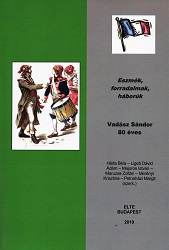
We kindly inform you that, as long as the subject affiliation of our 300.000+ articles is in progress, you might get unsufficient or no results on your third level or second level search. In this case, please broaden your search criteria.

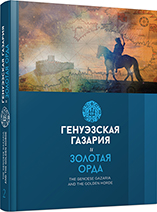
The authors present a discussion on medieval settlements located in Western Kazakhstan: Kyzylkala, Ketikkala, Saraishyk, Aktobe-Laeti and Zhaiyk towns. They relate in general to the period of the 10th—14th centuries, although some of them also existed later (Saraishyk). Problems of historiography and formation of medieval urban culture, economic ties with other regions, as well as historical topography of sites based on archaeological research are discussed. Fortification of settlements, residential and farm buildings, main features of funerary rite practiced on the associated necropolises are considered.
More...
The excavation process of a unique medieval burial containing mercury in one of the kurgans of the Shumaevo burial ground was conducted with a number of methodological and analytical errors, that resulted in an incorrect attribution of the complex to the period of the Golden Horde. “Technical details” that were taken for granted without any critical examination were reproduced in a number of publications and engendered a number of invalid conclusions regarding the origin, social station and spiritual habits of the Shumaevo warrior. New data obtained from studying textiles from the burial indicate the mistaken dating of the burial and the premature nature of the conclusions regarding the complex’s connection with the political and cultural history of the Mongols. The burial was made by the early medieval nomads that were dominant in Central Asia long before the arrival of the Mongols.
More...
The author reviews places where Polovtsian stone sculptures were found on the territory of the Kuban steppe and Eastern Trans-Kuban. First statues were delivered to the Museum in the late nineteenth century, and are still delivered nowadays. Before the revolution, there was no regular reporting about original locations of such finds. In 1950s — early 21st century, statues were brought from villages located on the territory of the Central steppe area in the middle Kuban area and Eastern Trans-Kuban. Finds of the Polovtsian stone sculptures are a valuable source on the geography of the Polovtsian nomadic camps in the Kuban basin.
More...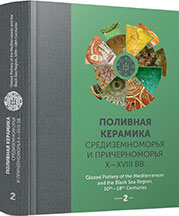
The study of medieval and post-medieval pottery in Greece and the Eastern Mediterranean has attracted significant interest in recent years. The purpose of this paper is to outline the main trends in the medieval countryside based on the evidence of archaeological regional surveys in central and southern Greece. These projects have established that glazed pottery circulated widely in the 12th and 13th centuries CE. The availability of substantial bodies of ceramic material from rural areas allows us to address questions of production and consumption patterns over time. It is well documented that in southern Greece the quantity of glazed wares increased dramatically after the late 11th century. This increase most likely indicates changes in the organization as well as the technology of glazed pottery production.This paper also includes a case study from the region of Nemea, in southern Greece. The Nemea Valley Archaeological Project (NVAP), an intensive regional survey undertaken in the 1980s, has established that glazed pottery is widely distributed in the Nemea valley and the surrounding area. NVAP also identified a medieval pottery workshop, which, most likely, produced glazed pottery. In addition, the excavations of the Sanctuary of Zeus at Nemea, have recovered large amounts of well-preserved medieval pottery, including diagnostic glazed wares.
More...
The paper makes an overview of the imported Byzantine sgraffito pottery distributed in the towns along the Bulgarian Black Sea coast from the end of the 11th — 12th century until the end of the 14th century. These are the following types: “Fine sgraffito ware”, “Painted fine sgraffito”, “Incised sgraffito” “Champlevé ware” and “Elaborate incised ware”. Forms of vessels, specific decoration and designs are described. Their chronology is based on analogies with similar finds from Byzantine territories.
More...
This article analyzes the Middle Eastern artistic ceramics of the turn of the 10th—11th centuries and 11th century from the Volga Bulgaria sites. Among the antiquities found in Eastern Europe, these items represent a rare and unique category of eastern imports. For a more complete characteristics and reliable attribution, chemical composition of the glaze and the clay base was determined by means of the scanning electron microscopy (SEM), mineral composition of the ceramic base of most impressive artifacts was identified by the X-ray phase analysis. As a result, the origin and dating of the Mesopotamian luster-painted tableware and Iranian vessels of the 11th century of “Sari” type was determined. The emergence of the imported Middle Eastern art works in the Middle Volga Region, in my opinion, is one of the evidences of the initial stage of Volga Bulgarian urban culture formation during the 11th century.
More...
This article focuses on the red-clay glazed ceramics of medieval Shamkir city, the ruins of which are located in the western region of the Republic of Azerbaijan, on the left bank of the river Shamkirchay. Wheel-made glazed ceramics of Shamkir is manufactured from well-prepared high quality levigated clay and is evenly baked. Main decoration techniques applied on glazed ceramics in 8th — 10th centuries were the color of baked shard, engobe, manganese and copper oxyde and glaze. Painting with engobe colors prevailed. The second stage in the development of artistic ceramics of Shamkir, encompassing 11th — beginning of the 13th century, was characterized by some innovations in decoration technology. The products that were decorated with engraving, the reserved technique, manganese and white painted engobe coating, engraving on manganese paintings, polychrome products under the glaze were widely used. The decor is dominated by geometric patterns, rarer plant, epigraphic and figurative motifs. Widespread rise of pottery production which began in the 9th century continuously evolved and reached its apogee in the 12th century.
More...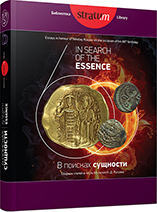
The typology of baptisteries of Byzantine Cherson of 6th—9th centuries is studied in the article. By the middle of the 7th century, each region of the city had its own temple with a baptistery, and their total number could reach nine. The overwhelming number of baptismal fonts were of small size and depth, and were intended for the baptismal rite, mainly over small children. Such baptisteries did not need any catechumens or hrismarions. In four cases the ponds of small fonts were raised above the floor and attached to the wall, but there were also fonts built in level with the floor, for the baptism of adults. The ponds were cut down in the rock, wrought from solid stone or built from plinth with the cement. They were shaped as a circle, polyhedron, semicircle, rectangle, or a three-conchal cross. There are finds of portable, mobile marble fonts. Baptisteries of Cherson can be divided into two groups: built as a detached building or as a part of a temple (the latter are most numerous). Among them, there are a few processional, “enfilade” baptisteries and more numerous single-chamber baptisteries. Arranged most often in the southern part of the temple, they had access to the altar. In addition, among them there were baptisteries of pure type and baptistery-martyria (at the Western basilica, “temple with the ark” no. 19 and in baptistery no. 24 at the Great Basilica). They reveal a noticeable influence of the Christian East.
More...
Another Old Russian sealing mark was found in 2019. On its obverse, there is an image of a bident, and a two-line inscription СВѦ on its reverse, carved in the stamping mold, without allowing for the print. The token on this sealing mark belongs to an earlier unknown type. It was owned by one of Vladimir Monomach’s descendants. Rarity of tokens similar to the discussed one suggests that owners of tokens from this group could make up a small and probably early extinct branch of Rurik family. The bident on the discussed sealing mark could be owned by Svyatopolk († after 1192), one of Mstislav the Great’s grandsons and Vladimir Mstislavich’s son.
More...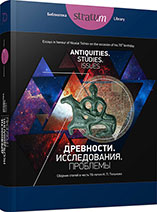
Archaeological research on the early history of Hungarians has gone through considerable change during the past decades; a new, critical approach has emerged. The most recent inspection of the archaeological material shows only few and rather debatable connections to the Saltovo culture; however, the only recently identified Subotsci horizon near the Dnieper demonstrates much stronger links to the early Hungarian material culture. The origins of the Subotsci horizon, as well as the origins of Hungarian conquerors, point to the Volga-South Ural region.
More...
As a result of its unique geographical position, the Carpathian-Dniester region felt a strong impact from the cultural and historical worlds of neighboring regions in the period of 5th—11th centuries. Various peoples penetrated from neighboring regions at different times on the territory of its eastern part — in the Pruto-Dniester interfluve. Among them: Slavs, Turkic-Bulgarian peoples, Alans, Hungarians, representatives of different cultures: Luka-Raikovetskaya, Saltovo-Mayaki and Balkano-Danube. The appearance in the region of the West Slavic population had a particular importance and left antiquities of Echimăuţi-Alcedar type. The synthesis of the cultures of Echimăuţi-Alcedar and Luka-Raikovetskaya laid the basis for the formation of the Old Russian culture of the Prut-Dniester region in the 10th—11th centuries. The Ancient Russian culture of these region was not homogeneous by its origin and reflected the presence of all migration waves in the Dniester-Prut interfluve.
More...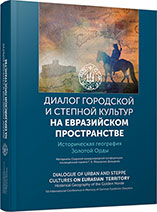
In 2012—2015, the Koksharovka-8 burial complex site having no analogy in Primorye medieval archeology was investigated. The remains of a monumental building of rectangular shape, 15 × 16 m built of stone slabs were studied. The design features of the structure and stages of its construction were identified. The studies have shown that a high-ranking nobleman was probably buried there. This is evidenced by both the monumental character of the structure and the nature of the grave goods, including items made of precious metals, most of which were looted by robbers as early as in the Middle Ages. The monument is directly related to the Koksharovka-1 hill fort site, where similar ceramic material has been discovered. Based on the study of the artifacts and radiocarbon analysis data, the burial complex may be tentatively dated to the 10th—11th cc.
More...
The author discusses the possibility to apply methods of geographic information systems to study development dynamics of a medieval city and uses Bolgar as a case study. The archaeological components allowing reconstructing the dynamics of the urban area are characterized. These components include: the cultural stratum with good stratigraphy, chronological topography of the finds, and distribution of archaeological urban structures. Among the latter, the following items are identified: monumental buildings, urban planning elements (streets, squares, etc.), remains of aboveground dwellings and household structures, remains of dugout dwellings and household structures, fortification objects, industrial and agricultural facilities (furnaces, traces of arable land), burial grounds and hydraulic structures. The research involved drawing of cartograms to represent Bolgar historical and social topography.
More...
The author considers the problem of localization of the Polovtsian stone sculptures on the territory of the Kuban River and eastern Kuban area steppes. The statues have been delivered to the museum starting from the late 19th century and are still delivered today. Before the revolution, the findings were not always localized. In the 1950s to the early 21st century, the statues were delivered from villages located in the territory of the Central steppe area, from the Middle Kuban area, and Eastern Kuban area. The findings of the Polovtsian stone sculptures are a valuable source on the geography of the Polovtsian nomad encampments of the Kuban area.
More...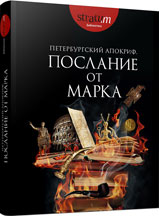
The article presents the materials of the two richest burials in barrows in the Kuban steppe, dated from the Great Migration epoch. The detailed analysis of the multiple inventory items (polychromatic objects, buckles and belt decorations, cauldrons, weapons, etc) makes it possible to date the burial in Kalininskaya to the first half of the 5th century, and the burial in Malay — to the middle of the 6th century.
More...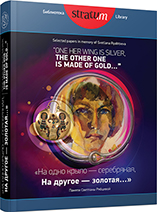
Big fingered fibulae of the East German tradition, such as Archar-Histria type, are addressed in this article. In the late phase of the Great Migration Period, they spread throughout the East Roman Empire, south of the Danube, as well as in the Crimea. These fibulae belong to the East German tradition of women's costume and date from the second half of the 5th — the beginning of the 6th centuries. Most likely, they spread from the northern part of the Balkan Peninsula along with migrations of the Goths to the West and the East. Perhaps, the finds of such fibulae in the Crimea (Luchistoe, Artek, Kerch) reflect one of the Gothic migrations from the Balkans, not recorded by written sources.
More...
The article examines two categories of female ensemble from the hoard found at the Elshino hillfort. This hoard, like the small one from Kartavtsevo hillfort, is considered among the group of hoards of the late Moshchiny culture (7th cent.). The Elshino hoard is similar to the Dnieper hoards (1st group), however the first one has a plenty of specific adornments. Some of them can be clearly divided into two categories whose origin lies in antiquities of the 1st half of I mil. AD. They are plated temple rings and cylindrical pendants. Prototypes of temple rings were part of the ensemble used by the population on the Upper Oka in the first centuries AD (the antiquities of Novo-Kleymenovo type). In the 3rd — the 1st half of the 4th cent., these adornments were included as components of the ensemble worn by the population of the Middle Oka and Suzdal Opolye. Prototypes of cylindrical pendants were widespread throughout the European Barbaricum. Later versions of such pendants appeared in the Upper Oka region in the Hunnic epoch. They are known from Velegozh hoard (Moshchiny culture). Single pendants were also found in the graves of the Ryazan Finn of the 2nd half 5th cent. These relict adornments developed in the context of the female ensemble of the late Moshchiny culture in the 3rd quar. of the I mil. AD. The ensemble was synthesizing elements of various origins.
More...
A finger ring with a pentagram was found in tomb 7 of the Gorzuvity necropolis, which served as the basis for this research in order to study the origin and the distribution of such jewelry, to identify analogies and to clarify their dating. Parallels from the South-Western Crimea and from other territories of the Byzantine world are given. A study of sample of such rings allowed us to identify several features that are most characteristic of the 10th—12th centuries. On this basis, the ring with pentalpha from Gorzuvity necropolis was previously dated to the 9th—11th centuries, not excluding the 12th century. Perhaps, with the help of the natural science methods implemented at present time, we will be able to clarify this date. The pentagram rings are of Byzantine origin, since they were distributed both in Byzantium itself and in its adjacent territories. Considering the finds from closed complexes, the rings appear in the 6th—7th centuries, the most widespread being from the 9th to the 11th centuries, their number dropping in the 12th century. Apparently, it was not an expensive mass production, these products being worn by citizens and residents of settlements. Such rings had an apotropaic character, because the image of the pentagram was supposed to ward off misfortune and evil from a person, whereas the signs of wear indicate that these jewelries were worn daily. Pentagram rings certainly reflect Byzantine fashion, they demonstrate the aesthetic and religious preferences of the peripheral population and testify to a uniform culture in the Byzantine world in the Middle Ages.
More...
The collection of the National Museum of the History of Ukraine contains a hoard found in the village of Novi Bezradychi (Kyiv oblast, Obukhiv region). The hoard was handed over to the Museum in 1988. Near the place where the hoard was found, in the village of Stari Bezradychi, there are ramparts of the Ancient Rus’ fort dated back to the 11th — 13th centuries and identified by the researchers as the Ancient Rus’ town of Tumoshch, which is mentioned in chronicles. To date, the hoard has not been introduced into scientific discussion. The hoard contains six items: twisted torques and twisted bracelets, as well as two unidentifiable fragments of décor. A feature of the hoard is the lack of locks and tips for the torques and bracelets; and this complicates the dating of that complex. The bracelets and torques fall within the turn of the 11th and the 12th centuries through the end of the 12th century, but the crinum-shaped ornaments on the decorative plate are characteristic of the second half of the 12th — the mid of the 13th century. Generally, this set of items can be dated to the turn of the 11th and 12th centuries through the second half of the 12th century and the beginning of the 13th century. The preservation of the hoard and the broken-off jewelry tips make it possible to consider the hoard as a stock of raw material for craftsman’s work and probably possessed by a jeweler. Burying of the hoard could well have been caused by the Polovtsian raids, as well as by seizing and plundering of Kyiv by the troops led by Andrey Bogolyubski in 1169, and also by the Tatar-Mongol invasion.
More...